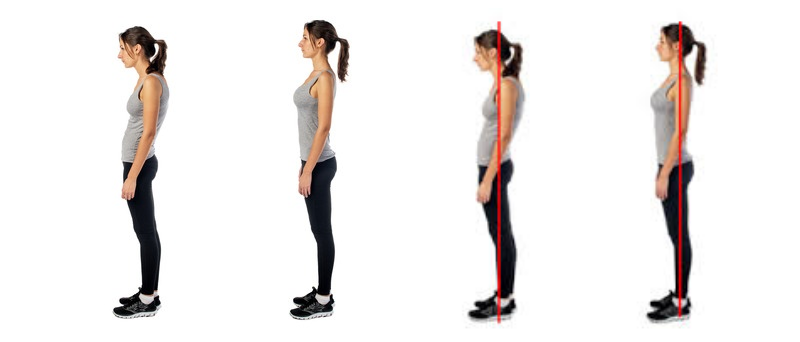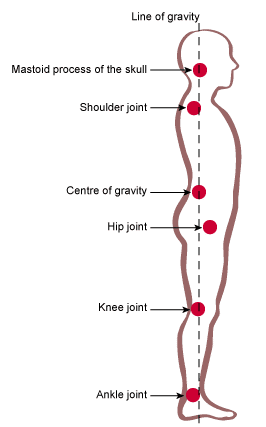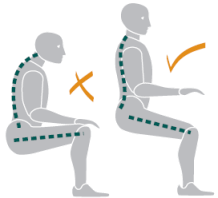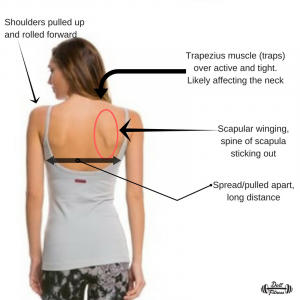
We are often told “stand upright or “don’t hunch your shoulders” when standing with poor posture (my favourite is “pull your gut in!!), but what exactly determines someone’s posture (good or bad)?
This article will delve into the anatomy of good posture, the muscles that are required to hold good posture (how these muscles need to be conditioned to allow you to maintain this postural position all day) and key factors in achieving a good posture.
Anatomy of Good Posture

- Stand tall!
- Think tall neck but keep your chin tucked in. Avoid tilting your head forward, backward or sideways.
- Keep your shoulders back, your knees straight and your back straight.
- Lightly draw in your core stomach muscles. Avoid tilting your pelvis forward.
- Avoid locking the knees.
- Stand with weight over the centre of your feet.
.
Poor posture can lead to a head forward position that has a cascading effect down the entire body:

- Head moving forward shifts the COG.
- To compensate, the upper body drifts backwards.
- To compensate for the upper body shift, the hips tilt forward.
- Leading to head, neck, mid-back and lower back problems.
How to quickly check your standing posture

Check out my video on developing good standing posture here.
Stand against a wall with shoulders and bottom touching wall. The back of your head should lightly touch the wall. If you can’t do this without pain or strain, you may have some restriction of some spinal joints, ligament or some muscle tightness.
This is a great exercise to demonstrate what muscles you need to contract and the position you need to place your body in to achieve a good posture. If your head/hair isn’t lightly touching the wall don’t just lean your head back to touch the wall, keeping your head in a neutral position (ensure your nose isn’t pointing upwards) gently lift up your chest/ribcage until your head/hair lightly touches the wall behind you. This movement is activating your upper and lower erector spinae muscle groups to bring your spine into the correct postural position.
At the same time, slightly contract your abdominals (a mini core bracing contraction) not so hard that you have block off your breathing to achieve this, and this will assist in maintaining a correct pelvic tilt which now places your body in your ideal postural position.
Once you have achieved this position, the long term challenge is to train these key muscle groups to maintain this position all day (also to be able to hold this posture in the more difficult sitting position). The inability to hold this position even for a few minutes is what I call “Posture Fatigue”.
Posture Fatigue
Posture fatigue represents an inability to maintain your normal upright posture for an extended period. The muscles you need to contract and remain under tension don’t have adequate endurance to achieve this goal due most likely due to your muscles & joints having adapted to your long-standing poor posture.
Postural muscle fatigue can be improved with repetitive contraction and periodic posture breaks and the conscious awareness of your own posture and knowing what posture is correct will help you consciously correct yourself. This will help to strengthen and improve your postural muscle endurance & with practice/training, the correct posture for standing & sitting will gradually replace your old posture.
Like any muscle training, you need to start off with short periods of postural control, followed by breaks for the position (to allow your muscles to recover from the unfamiliar lengthy contractions).

As your muscular control/endurance improves, you then work on holding good posture for longer time periods and once you feel you are able to hold a good posture for an extended time (upwards of 30-minutes), I would then suggest you start the training process again in a seated position (the most difficult situation to maintain good posture as your COG will now be more forward than in a standing position thereby placing constant pressure on your upper body to bend forward at the lumbar spine).
Muscles involved in good posture
The inspiratory muscle contract in order to lift the rib up against gravity. These inspiratory muscles are: external intercostals (b/w ribs), sternocleidomastoid (neck), scalene (neck) and most importantly the diaphragm.
The extensor muscles of the neck, used to point the nose towards the sky and assist in keeping the chest upright are the upper erector spinae muscles.
Shoulder Girdle

Anchoring the shoulder blades to the spine is triangular shaped muscle called the trapezius. This muscle covers the neck, shoulders and thorax. One imbalance of this muscle results in the shoulder blades moving up and out leading to a rounding of the shoulders. This can also accompanied by an internal rotation of the shoulder joint (a good reason why practising your posture whilst in the “Anatomical Position” – arms by your sides, palms facing forward and elbows facing to the rear is helpful in placing your shoulder joints in the correct alignment).
Core
Beginning with the muscles on the back side of the body are those which run laterally to the spine, called the lower erector spinae muscles. Individually, they are the spinalis, longissimus and iliocostalis, all working together to extend the spine. The multifidus muscles, a smaller group deep in the back, connect the vertebra and maintains correct alignment along the length of the spine.
From the front of the body, the abdominal muscles are probably the most widely known of the postural muscles. The rectus abdominis is a long vertical muscle running the entire length of the abdomen, while the oblique muscles stretch around the sides and front of the stomach like a corset. As previously discussed, the rectus abdominis has little role in core support or postural control.
The Transverse abdominis is a flat, horizontal muscle that wraps around the abdominal region and is largely responsible for creating adequate pressure through your mid-section to allow you to maintain an upright posture for extended periods.
Aspects to achieving good posture – In Summary
- Good muscle flexibility
- If you are tight in any postural area, this will limit your ability to get into the right posture and more importantly maintain good posture (if it is hard work getting your body into this position then it will be very difficult to maintain this position for any extended time).
- Normal motion in the joints
- This is similar to point 1, if you have limited ROM (Range of Motion) in your neck, shoulder or lower back/hip joints then it is also going to be difficult to firstly get into a correct postural position and all but impossible to maintain this position over an extended time.
- Strong postural muscles
- This is the key aspect of good posture, and there are two key parts to this aspect of posture:
- Muscle Strength
- You must develop all postural muscles such that they have the strength to be able to place your body in the correct postural position.
- Muscle Endurance
- Once you have the basic strength, you must then train your postural muscles to be able to contract isometrically (tension but no movement) for long time periods (this takes a lot of work to be able to do this in both a standing and seated situation).
- Muscle Strength
- This is the key aspect of good posture, and there are two key parts to this aspect of posture:
- A balance of muscles on both sides of the spine
- Any imbalance b/w front/back, side to side, upper/lower musculature may result in it being difficult to firstly get into the correct posture and secondly be able to maintain this body position for any time.
- Awareness of your own posture, plus awareness of proper posture which leads to conscious correction.
- This is key – you will find early on that many of your postural muscles will fatigue very quickly (within minutes of you holding the correct position). You should try to follow these tips to help in integrating good posture into every aspect of your day to day life:
- When ever you stand up – think about lifting your chest up, shoulders back and contracting your core (activating your TA – belly button to spine).
- When you have to stand for any extended period, try not to place your weight on one side, stand evenly balanced, and focus on not letting your head or shoulders drop forward (the natural tendency).
- Your postural muscles will fatigue quicker if you are completely stationary for long periods, so regularly shift your weight from one foot to the other when standing for a sustained periods. Alternatively, stand in a walk-stand position and rock your weight from your front to back foot.
- This is key – you will find early on that many of your postural muscles will fatigue very quickly (within minutes of you holding the correct position). You should try to follow these tips to help in integrating good posture into every aspect of your day to day life:
- When you plan on sitting (the hardest position to maintain good posture), you should try to focus on these several tips:
- Sit up right in your chair (don’t lean back against the back rest if you have one). If you are going to use your back rest, then ensure it is vertical/upright so that you don’t lean back – the back rest is just assisting in you keeping your lower back straight.
- Push your butt firmly against the back of the seat and make sure that your feet can touch the ground which will make it easier for you to maintain a neutral pelvic position.
- Focus on keeping your lower back straight and chest high if you are working on your computer.
- This is a very difficult position to hold, so I would recommend that you get up from your seat very regularly to walk around for a minute or so – this will give all these postural muscles time to relax/recover before you re-sit and repeat.
Good Posture is a sign of a healthy musculoskeletal system. Make it a worthwhile task of developing a strong posture to maximise your functional health as you age.


